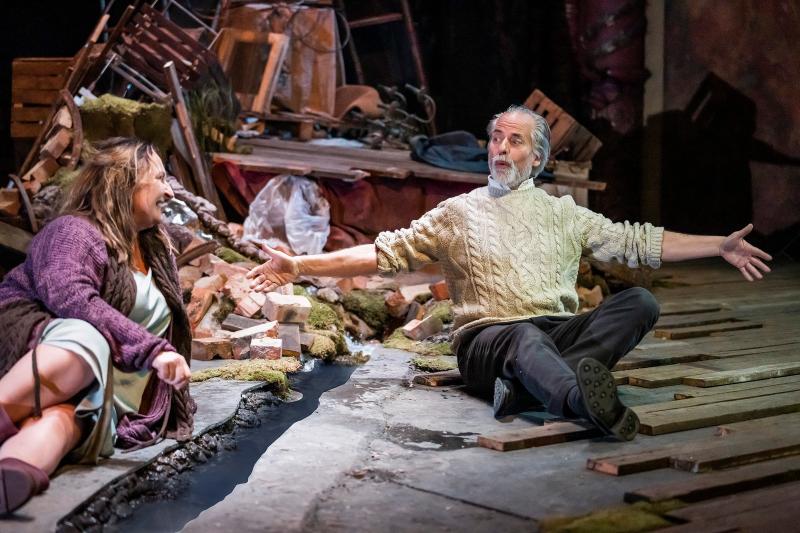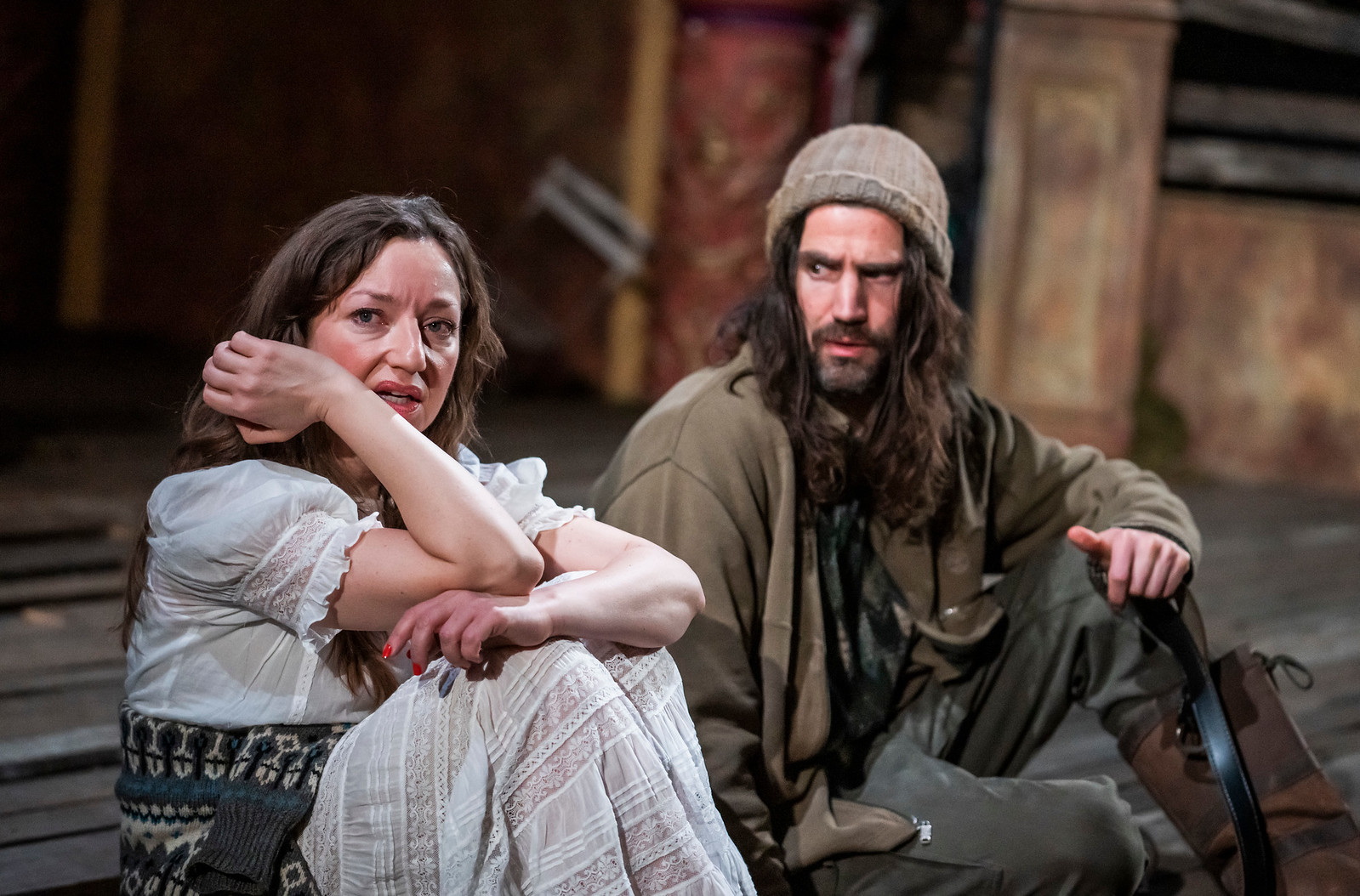When We Dead Awaken, The Norwegian Ibsen Company, Coronet Theatre review - living death, dying life | reviews, news & interviews
When We Dead Awaken, The Norwegian Ibsen Company, Coronet Theatre review - living death, dying life
When We Dead Awaken, The Norwegian Ibsen Company, Coronet Theatre review - living death, dying life
Ibsen anticipates Beckett in his strange final play, austerely staged with dashes of wit

In Ibsen's last and shortest play, further cut here, four people nominally climb a mountain, but actually seem to be crossing waste land towards the land of Samuel Beckett. It’s an amazing play in which reality is symbolic and symbols are real, where not one character is likeable and all speak with hallucinatory directness. The Norwegian Theatre Company, very much welcome back to the Coronet Theatre, do much of its strangeness justice.
Everyone who’s seen either the play or the film of Willy Russell’s Educating Rita will remember the protagonist’s response to the essay title “Suggest how you might resolve the staging difficulties inherent in a production of Ibsen’s Peer Gynt” - “Do it on the radio”. When We Dead Awaken is really a play for radio or film. Avoiding the kind of gimmicky attempt at an al fresco landscape which overwhelmed the Donmar drama of Swedes in the Alps Force Majeure, director Kjetil Bang Hansen and designer Mayou Trikerioti have jettisoned the settings of the three acts – outside a Norwegian spa hotel, a mountain health resort and the top of the mountain. They give us instead a house that looks as if it’s been bombed or long deserted, detritus piled up in a hill of sorts at the centre, a runnel heading downstage, vegetation growing in the cracks: the flotsam and jetsam of wasted lives. It’s a good use of the crumbling Coronet auditorium.  The four main characters adapt to the wildness, sitting on the broken planks and rarely on chairs, unwinding their bitterness, hatred and dim hope. Ibsen wastes no time in telling us who they are: egotistical sculptor Arnold Rubek (Oystein Roger), unfulfilled ever since he created what he seems to accept as a masterpiece; the artist’s model for that masterpiece Irene (Ragnhild Margrethe Gudbrandsen), jettisoned after what’s described by both, she bitterly, as an “episode” and since confined to a lunatic asylum, now followed about by a mostly silent carer; Rubek’s younger wife Maia (Andrea Bræin Hovig), longing for freedom; and the wild, satyr-like hunter Ulfhejm (Irish actor James Browne, pictured above with Hovig), who can partly satisfy that yearning.
The four main characters adapt to the wildness, sitting on the broken planks and rarely on chairs, unwinding their bitterness, hatred and dim hope. Ibsen wastes no time in telling us who they are: egotistical sculptor Arnold Rubek (Oystein Roger), unfulfilled ever since he created what he seems to accept as a masterpiece; the artist’s model for that masterpiece Irene (Ragnhild Margrethe Gudbrandsen), jettisoned after what’s described by both, she bitterly, as an “episode” and since confined to a lunatic asylum, now followed about by a mostly silent carer; Rubek’s younger wife Maia (Andrea Bræin Hovig), longing for freedom; and the wild, satyr-like hunter Ulfhejm (Irish actor James Browne, pictured above with Hovig), who can partly satisfy that yearning.
Ibsen translator and biographer Michael Meyer has written about “a certain kind of abstract high-flown writing which in any prose sounds grandiose, even windy”, adding that Ibsen intended to write his last play in verse – though of course he didn’t want to admit this would be the endgame. The actors’ triumph is to make it seem inevitable, however strange, and while Ibsen pricks the artistic grandiosity of his alter ego with the reactions of the women he’s used, this production goes still further in making it actually funny at times.
 That, at least, is the case when Irene asks about the fate of her “child”, Rubek’s marble masterpiece “The Day of Resurrection”. It’s been buried alive in the tomb of a distant museum, he tells her, and is forced to confess that her sculptured figure has been moved back on a bigger plinth to accommodate all sorts of humans with bestial essence beneath their human masks swarming out of a curved and fissured earth, putting himself at the front as a figure tormented by guilt.
That, at least, is the case when Irene asks about the fate of her “child”, Rubek’s marble masterpiece “The Day of Resurrection”. It’s been buried alive in the tomb of a distant museum, he tells her, and is forced to confess that her sculptured figure has been moved back on a bigger plinth to accommodate all sorts of humans with bestial essence beneath their human masks swarming out of a curved and fissured earth, putting himself at the front as a figure tormented by guilt.
There’s a weirder kind of playfulness between Maia and her hunter – edgy, dangerous, ultimately resolving to “stitch our tattered lives together”. They descend to the existence that the older couple sees as death, while Rubek and Irene ascend to the new life. It’s unstageable, and some of Ibsen’s directions are read out by the actors. Is that it, we ask? But the playwright himself left us with a sketch of a final act: the brevity of old age, like a Shakespeare late romance.
As with everything else in the play this denouement aspires to music, with its haunting refrains, its central quartet; someone should write an opera on it, but one that would have to be as lean, hungry and, fitfully, lyrical as the original drama. All credit to Bang-Hansen for keeping the peripheral sounds to a minimum, Meanwhile, there’s music in the actors’ delivery, switching from Norwegian to English for the scenes with the stranger-hunter, though the most striking sing-songiness comes in the original language from Gudbrandsen’s Irene (pictured above right). See it: I guarantee you won’t find the play better, or even as well, done by a British company.
The future of Arts Journalism
You can stop theartsdesk.com closing!
We urgently need financing to survive. Our fundraising drive has thus far raised £49,000 but we need to reach £100,000 or we will be forced to close. Please contribute here: https://gofund.me/c3f6033d
And if you can forward this information to anyone who might assist, we’d be grateful.

Subscribe to theartsdesk.com
Thank you for continuing to read our work on theartsdesk.com. For unlimited access to every article in its entirety, including our archive of more than 15,000 pieces, we're asking for £5 per month or £40 per year. We feel it's a very good deal, and hope you do too.
To take a subscription now simply click here.
And if you're looking for that extra gift for a friend or family member, why not treat them to a theartsdesk.com gift subscription?
more Theatre
 Dracula, Lyric Hammersmith review - hit-and-miss recasting of the familiar story as feminist diatribe
Morgan Lloyd Malcolm's version puts Mina Harkness centre-stage
Dracula, Lyric Hammersmith review - hit-and-miss recasting of the familiar story as feminist diatribe
Morgan Lloyd Malcolm's version puts Mina Harkness centre-stage
 Reunion, Kiln Theatre review - a stormy night in every sense
Beautifully acted, but desperately grim drama
Reunion, Kiln Theatre review - a stormy night in every sense
Beautifully acted, but desperately grim drama
 The Code, Southwark Playhouse Elephant review - superbly cast, resonant play about the price of fame in Hollywood
Tracie Bennett is outstanding as a ribald, riotous Tallulah Bankhead
The Code, Southwark Playhouse Elephant review - superbly cast, resonant play about the price of fame in Hollywood
Tracie Bennett is outstanding as a ribald, riotous Tallulah Bankhead
 The Lady from the Sea, Bridge Theatre review - flashes of brilliance
Simon Stone refashions Ibsen in his own high-octane image
The Lady from the Sea, Bridge Theatre review - flashes of brilliance
Simon Stone refashions Ibsen in his own high-octane image
 Romans: A Novel, Almeida Theatre review - a uniquely extraordinary work
Alice Birch’s wildly epic family drama is both mind-blowing and exasperating
Romans: A Novel, Almeida Theatre review - a uniquely extraordinary work
Alice Birch’s wildly epic family drama is both mind-blowing and exasperating
 The Producers, Garrick Theatre review - Ve haf vays of making you laugh
You probably know what's coming, but it's such great fun!
The Producers, Garrick Theatre review - Ve haf vays of making you laugh
You probably know what's coming, but it's such great fun!
 Not Your Superwoman, Bush Theatre review - powerful tribute to the plight and perseverance of Black women
Golda Rosheuvel and Letitia Wright excel in a super new play
Not Your Superwoman, Bush Theatre review - powerful tribute to the plight and perseverance of Black women
Golda Rosheuvel and Letitia Wright excel in a super new play
 Cow | Deer, Royal Court review - paradox-rich account of non-human life
Experimental work about nature led by Katie Mitchell is both extraordinary and banal
Cow | Deer, Royal Court review - paradox-rich account of non-human life
Experimental work about nature led by Katie Mitchell is both extraordinary and banal
 Deaf Republic, Royal Court review - beautiful images, shame about the words
Staging of Ukrainian-American Ilya Kaminsky’s anti-war poems is too meta-theatrical
Deaf Republic, Royal Court review - beautiful images, shame about the words
Staging of Ukrainian-American Ilya Kaminsky’s anti-war poems is too meta-theatrical
 Laura Benanti: Nobody Cares, Underbelly Boulevard Soho review - Tony winner makes charming, cheeky London debut
Broadway's acclaimed Cinderella, Louise, and Amalia reaches Soho for a welcome one-night stand
Laura Benanti: Nobody Cares, Underbelly Boulevard Soho review - Tony winner makes charming, cheeky London debut
Broadway's acclaimed Cinderella, Louise, and Amalia reaches Soho for a welcome one-night stand
 The Pitchfork Disney, King's Head Theatre review - blazing with dark energy
Thrilling revival of Philip Ridley’s cult classic confirms its legendary status
The Pitchfork Disney, King's Head Theatre review - blazing with dark energy
Thrilling revival of Philip Ridley’s cult classic confirms its legendary status
 Born with Teeth, Wyndham's Theatre review - electric sparring match between Shakespeare and Marlowe
Rival Elizabethan playwrights in an up-to-the-minute encounter
Born with Teeth, Wyndham's Theatre review - electric sparring match between Shakespeare and Marlowe
Rival Elizabethan playwrights in an up-to-the-minute encounter

Add comment